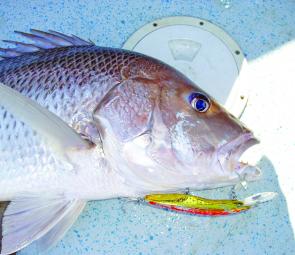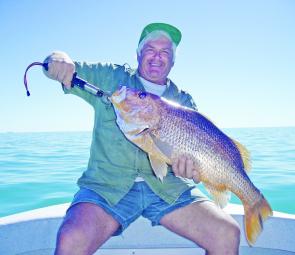I don’t know if it is the thrill of a fingermark’s hard-hitting strike or when a specimen is finally dragged to the surface, but something keeps urging me to pursue these big fighting machines.
Fingermark (big scale reds, large scale sea perch, golden snapper, Lutjanis johni) are popular targets for northern Australian anglers and are one of my favourite fighting species. So what is the best way to catch a fingermark? Livebaiting, jigging or casting lures? What about dragging a deep diver past the nose of one of these monsters?
Trolling for fingermark is not a new method but it is effective and lots of fun. When one of these brutes smashes a lure being trolled at 4-knots it’s like hooking a freight train. The fish will freeze for a second or two before streaking back to wherever it came from. These areas include reef, rocks, wrecks, or any other structure or object on the ocean floor they may call home. In the Gulf of Carpentaria fingermark hold in waters shallower (6-8m) than their east coast cousins. They are still harvested commercially in the Gulf’s deeper waters that are too far offshore for the average angler.
Traditionally, fingermark are found in deep holes, wrecks and bommies but there are a lot of fish that hold on what appears on the sounder to be just fuzz or a different coloured line along the bottom.
Some schools of fingermark will hold over a shoal or rubble patch on the bottom in 3m of water. Whether they live there or just visit for a feed is anyone’s guess, but it’s a great place to start trolling. To find a spot, use local charts and if you have a plotter on board look for wrecks and variations in the water depth. Examine these closely for irregularities in the line, or ‘squiggles’ for want of a better description. Most of these spots have the potential to house a bunch of hungry fingermark and other species. Once you have found a likely spot, mark it with your GPS or use a landmark.
If you rely solely on what your fish finder tells you then you may miss out on the action. Even if they are decent-sized fish that should mark on a fish finder quite easily, this does not always work. I have sounded over the same spot time and time again with nothing showing on the sounder in the way of big marks, but have still hooked good-sized fingermark on each pass. I use is a Lowrance X125 which is more than capable of marking fish well. When they are thick or in a school, fingermark can mark similar to a big school of bait rising off the bottom in a column of arcs that almost reach the surface. I have seen fingermark swimming around at the back of the boat feeding when they are really thick.
Before heading out to tackle one of these angry critters, make sure your equipment is up to the task at hand. Don’t go out there with your estuary flick stick or 6wt fly rod and expect to be treated nicely! I would suggest a minimum of an 8kg overhead or spin rod. At least 30-50lb braid! I used to be pretty old fashioned when choosing line, so I used 20lb mono for my first fingermark assault. Now I use 30lb braid in open water (shoal or rubble), and at least 50lb when fishing in tiger country.
A solid reel with a good drag is essential when battling a large fingermark. Something like a Calcutta 400 or an Abu 6000 or 6500 will suffice. Alternatively, something else around that size and capability will work. Line capacity is important. If you are fishing a nasty bottom and you have a bit of line out, you need to be sure you have enough to run them or steer them away from the structure, then have enough left for the fingermark to make his run for freedom back to the structure. A couple of hundred metres would be just enough. Once you get them clear of the danger zone they are quite easy to get to the boat, just heavy.
I like my lure to be as close to the bottom as possible on the first few passes. You have to expect a few snags so have the trusty old tackle back handy. If there are fish about, you should feel a bit of interest right away. There are plenty of other critters that hang with fingermark so a mixed bag is not unrealistic.
Sometimes the area you are fishing in these waters can be as small as the boat you’re fishing from, so try either circling back around to the mark or retrieve the lure, do a u-turn, cast out, and troll over your mark again. Circling is a pretty good way to determine if any other fish are in the area, and is a great way to accidentally come across more ground.
I have found that when trolling for fingermark the direction you approach the fish from is not as important as compared to trolling for barra for example. If it is tiger country and you manage to hook a few snags, try using a shallower diver on the next pass. This can be repeated until you have them on the chew only a couple of metres below the surface. Why do this? If it is 7m deep and you can get them to come up to 3m, you have a far greater chance of steering the fish away from the structure, therefore minimising chances of getting ‘blown away’.
I have found that using a bit more speed through the water when trolling for fingermark is a ticket to success. If you are familiar with trolling for mackerel, then that’s the speed to use. If not, about 4 knots with or against the current should do the trick. A handy hint when trolling for big fingermark is to speed up a bit more once you get a bump or hit but no hook up. I’m not sure if this aggravates the fish or creates a challenge for them to pursue frightened prey, but it works. Quite often it is after you have increased the trolling speed that you will hook up, and hard.
Once again, this is only what has worked for me. I have not tried every lure out there and no doubt there are plenty that will work just as well as the ones I have used. When it comes to colour, I have a very biased opinion: any colour as long as it’s gold! Not long ago I discovered that companies actually made lures in colours other than gold. And do they work? Fingermark can be fussy, but if you have green, white, red, blue, or yes even gold, and it is put in the right place at the right pace, I have every reason to believe that you will be rewarded with a big fingermark. In the Gulf waters I like the bigger RMG scorpions in the 3-8m range. A fantastic new product that has hit the market is JJ Lures’ Aussie Jumpers. These are the same guys who produced the famous StumpJumper lure. They have interchangeable bibs so if you only have one white one left, you can change the depth at which it swims and keep catching fish.
So if you fish the east coast or the Gulf waters and you have a soft spot for big fingermark, try something different next time you’re out after them. Toss a lure over the back and drag it around where you think they might be, you just never know.
Reads: 7032
Gold lures, like this Halco deep diver, can be successful in producing fingermark.

When fingermark get this big, they bring a smile to any angler’s face!

Fresh from the water big fingermark are often silvery across the belly, which turns brilliant gold after death.

The gulf waters around Karumba are home to many fingermark this size and bigger.

Trolling over rough country for large fingermark can be very rewarding but can cost a lot in lost lures!




